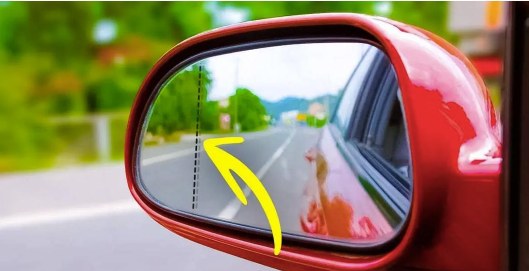When looking closely at your car’s side mirrors or windows, you might notice black dots or a gradient pattern that blends into the mirror or glass. These seemingly small and unnoticed features are actually integral parts of your vehicle’s design, serving critical safety and functional purposes. In this article, we’ll dive into the reasons these black dots exist and how they contribute to the performance and safety of your car.
Understanding the Black Dots on Car Mirrors
The black dots on car mirrors are primarily found on aspherical mirrors, a design that helps drivers reduce blind spots and improve visibility. These mirrors differ from traditional flat mirrors as they feature a subtle outward curve on the outermost section, providing an expanded field of view.
Key Functions of the Black Dots and Stripes:
- Visual Transition Between Sections:
- On aspherical mirrors, a vertical stripe or pattern of black dots marks the transition between the flat reflective surface and the curved portion. This helps drivers easily distinguish between the two sections of the mirror.
- The curved portion expands your view of the blind spot, but objects in this area may appear slightly smaller. The black demarcation helps reduce confusion and aids in judging distances more accurately.
- Enhanced Depth Perception:
- By marking the boundary between the two reflective zones, the black dots create a reference point for drivers. This improves depth perception and assists in making better-informed decisions, such as merging or changing lanes.
Black Dots on Car Windows: The Role of the Frit Band
The black dots seen on car windows, particularly around the edges, serve entirely different purposes. Known as the frit band, these dots are not just decorative—they are made of ceramic paint baked into the glass during manufacturing and serve several crucial roles.
Functions of the Frit Band:
- Secure Adhesion:
- The frit band provides a rough, non-smooth surface on the edges of the glass, enabling adhesives to bond more effectively. This ensures the glass remains securely attached to the car’s frame, which is vital for the structural integrity of the vehicle.
- UV Protection:
- The black dots and band shield the adhesive layer from exposure to UV rays, which could otherwise degrade it over time. This added protection increases the durability of the window installation.
- Thermal Regulation:
- The gradient pattern of the dots helps to distribute heat evenly across the glass, minimizing the risk of stress fractures caused by sudden temperature changes. This is particularly important in extreme weather conditions.
- Aesthetic Enhancement:
- Beyond their functional roles, the dots create a visually appealing gradient, providing a smooth transition from the opaque edge of the window frame to the transparent glass.
Why These Features Matter for Safety
The black dots and stripes might seem insignificant, but they play a key role in ensuring your safety and enhancing your driving experience:
- Improved Blind Spot Awareness:
- The expanded view provided by aspherical mirrors reduces the likelihood of accidents during lane changes and turns. The black stripe acts as a visual guide, helping drivers interpret the mirror’s reflection with greater accuracy.
- Vehicle Integrity:
- The frit band on windows contributes to the car’s structural integrity. In the event of a collision, the adhesive layer supported by the frit band keeps the windshield or window securely in place, offering additional protection to occupants.
- Durability:
- By protecting adhesives from UV rays and preventing thermal stress, the black dots extend the lifespan of the glass components, reducing maintenance and repair costs over time.
A Brief History of Automotive Mirror and Window Design
The use of aspherical mirrors and frit bands in automotive design is a relatively modern development. Early car mirrors were flat, offering limited visibility. With advancements in engineering, manufacturers began incorporating aspherical designs to address blind spots—a significant breakthrough in road safety.
Similarly, the inclusion of frit bands in window manufacturing became standard practice as automotive glass technology evolved. These bands were developed not only for their adhesive properties but also to address issues related to heat and UV exposure, ensuring longer-lasting installations.
Tips for Maximizing the Benefits of These Features
To make the most of the black dots and stripes on your car mirrors and windows, consider these tips:
- Understand Your Mirror’s Field of View:
- Familiarize yourself with how the flat and curved sections of your side mirrors work. Practice interpreting reflections to improve your situational awareness.
- Maintain Cleanliness:
- Keep your mirrors and windows clean to ensure unobstructed views. Use appropriate cleaning solutions to avoid damaging the frit band or mirror coatings.
- Regular Inspections:
- Check for signs of wear or damage to the frit band and ensure that the adhesive layer on your windows is intact. Addressing minor issues early can prevent larger problems down the line.
- Use Blind Spot Monitoring:
- Combine your knowledge of aspherical mirrors with blind-spot monitoring systems for added safety. These systems complement the extended view provided by the curved mirror section.
Conclusion
The black dots on car mirrors and windows are far more than aesthetic features—they are integral to the functionality, safety, and durability of your vehicle. By reducing blind spots, protecting adhesives, and regulating heat, these small design elements contribute significantly to the overall driving experience. Understanding their purpose helps drivers make better use of these features, ensuring a safer and more enjoyable journey on the road. So, the next time you notice those black dots or stripes, you’ll appreciate the ingenuity behind their design.

